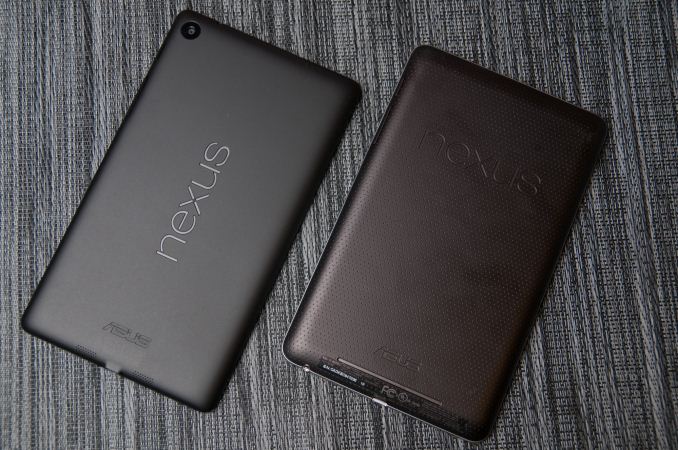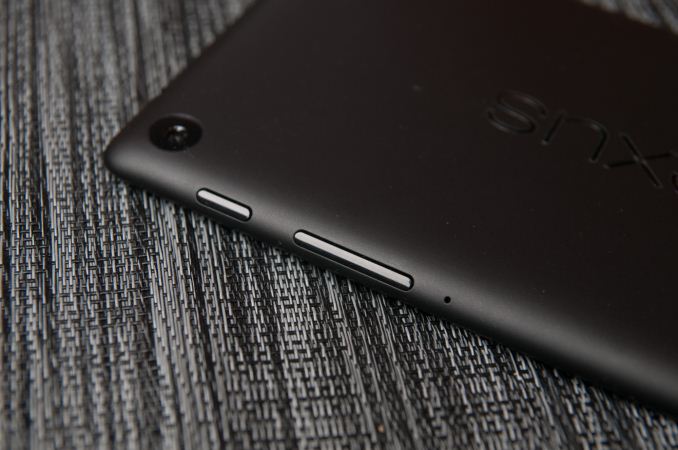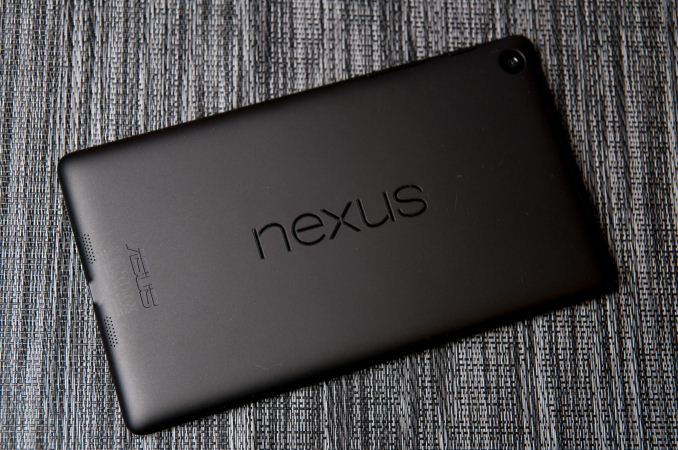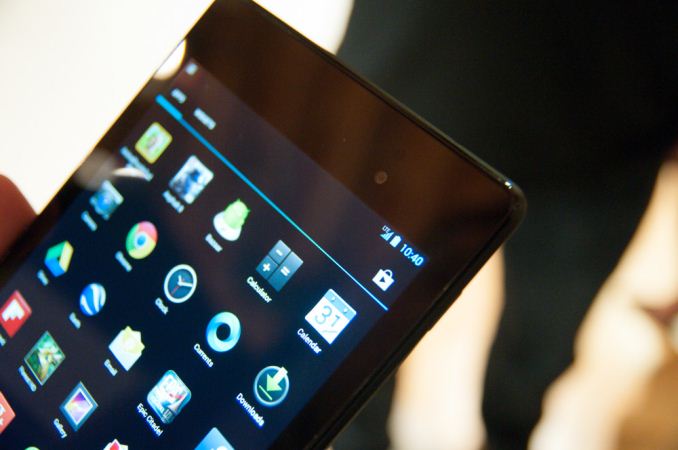Nexus 7 (2013) - Mini Review
by Brian Klug on July 27, 2013 12:54 AM EST- Posted in
- Tablets
- Snapdragon
- Qualcomm
- Android
- Mobile
- APQ8064
- Nexus 7
- Android 4.3

At an event in San Francisco, Google announced an updated version of the popular Nexus 7 tablet which first appeared at last year’s Google I/O. The big new features update the Nexus 7 platform with inclusion of a 1.5 GHz Snapdragon S4 Pro (APQ8064) SoC, 1920x1200 display by JDI (Japan Display Inc), as well as 5 MP rear facing camera, 1.2 MP front facing camera, stereo speakers, dual band WiFI, wireless charging (Qi) and a thinner and lighter chassis. It’s a major update that keeps the competitive price point that made the original Nexus 7 appealing (the lineup starts at $229 for the 16 GB model) while bringing numerous much-needed improvements that people have asked for.
First off, it’s shocking how much of a difference the change in thickness and weight makes. The new Nexus 7 feels considerably lighter and thinner in the hand than its older counterpart. Gone is the textured rubberized (almost driver glove-like) material on the back, in its place a flat, uniform soft touch material. There’s Nexus emblazoned in landscape on the rear, which is a bit puzzling next to the 90 degree rotated ASUS down below. It irritates my OCD sensibilities seeing the two logos inexplicably perpendicular and right next to each other, but I suppose Google thinks this helps emphasize how much the Nexus 7 and Android platform are really tablet-friendly now, with landscape view support throughout the core apps.
The rear facing camera is in the extreme top left, next to the power and volume rocker buttons, and top speaker. The Nexus 7 build and finish does feel a bit more plasticky to me this time around, but that’s almost expected given the price point, and it isn’t a major dig on the hardware at all. That’s not to say it isn’t sturdy or well put together, but just that the original Nexus 7 left a stronger impression on me last time, and I’ve been spoiled by the ASUS FonePad since then. The edge chamfer also helps the Nexus 7 feel a bit more like the Nexus 4 with its rounded edge. The previous Nexus 7 came to a point that could be a bit sharp at times.
What’s a little awkward is how tall the bezel at top and bottom looks on the Nexus 7, I’m warming up to it. On paper the new Nexus 7 is smaller in almost every dimension, in reality the elongated aspect ratio is definitely a bit pronounced here. There’s also still a notification LED well hidden under the glass at bottom in the center.
On the back is the new 5 MP rear facing camera, buttons (which hug the edges), a microphone port, and speakers. The speakers fire out the back of the Nexus 7 and look like they have good separation (obviously the best that the device’s size affords – top and bottom), but I don’t have a good feel for just how loud they go quite yet. Having stereo is a dramatic improvement for the audio part of video and multimedia consumption, and Android does 5.1 virtualization out the speakers as well. On the connectivity side of things there’s microUSB at the bottom with SlimPort video out, and a 3.5mm audio jack. I know a lot of people were hoping for inclusion of line in on the 3.5mm audio jack but I can confirm it isn’t present.
| Nexus 7Tablet Specification Comparison | ||||
| ASUS Nexus 7 (2012) | ASUS Nexus 7 (2013) | |||
| Dimensions | 198.5 x 120 x 10.45mm | 200 x 114 x 8.65mm | ||
| Chassis | Plastic + Rubber back | Plastic + Soft Touch back | ||
| Display | 7-inch 1280x800 IPS | 7.02-inch 1920x1200 IPS | ||
| Weight | 340 g | 290 grams (WiFi), 299 grams (LTE) | ||
| Processor | 1.3 GHz NVIDIA Tegra 3 (T30L - 4 x Cortex A9) | 1.5 GHz Qualcomm Snapdragon S4 Pro (APQ8064) | ||
| Memory | 1 GB | 2 GB DDR3L | ||
| Storage | 8 GB / 16 GB | 16 GB / 32 GB | ||
| Battery | 16 Whr | 15.01 Whr | ||
| WiFi/Connectivity | 802.11b/g/n, BT, NFC | 802.11a/b/g/n, BT 4.0, NFC | ||
| Camera | – |
5.0 MP Rear Facing w/AF 1.2MP Front Facing |
||
| Wireless Charging | – | Yes (Qi Compatible) | ||
| Pricing | $199/$249 |
$229/$269 (WiFi 16/32 GB) $349 (LTE) |
||
My only real complaint with the new Nexus 7’s in hand feel and build is with the power button and volume rocker, which feel somewhat mushy to me. I had issues taking screenshots even at times. It’s a minor gripe, but with only three buttons on the whole device, and generally good execution by ASUS with buttons on tablets, it surprised me. I guess I also do miss that racing glove-inspired texture in the soft touch on the back of the original Nexus 7.
| Nexus 7 (LTE) Band Coverage | |||||
| Model | GSM/EDGE Bands |
WCDMA Bands (HSPA+ 42) |
LTE Bands (UE Category 3) |
||
| North America Nexus 7 LTE |
Quad Band (850 / 900 / 1800 / 1900 MHz) |
HSPA+: 850/900/1900/2100/AWS(1700/2100) MHz (Bands: 1/2/4/5/8) | 700/750/850/1700/1900/2100 MHz (Bands: 1/2/4/5/13/17) | ||
| Europe Nexus 7 LTE | 800/850/1700/1800/1900/2100/2600 MHz (Bands: 1/2/3/4/5/7/20) | ||||
There’s a version of the Nexus 7 with 32 GB of storage and LTE onboard for $349 which will appear ‘in the coming weeks’ and includes support for AT&T, T-Mobile, and Verizon LTE in the USA on one piece of hardware. This is the first single SKU solution I’m aware of with coexistence of Bands 13 and 17 (Verizon and AT&T respectively) on the same device, which is awesome. There’s a model with Bands 3, 7, and 20 for Europe as well, so they’re not left out of the LTE fray. I had a chance to quickly get a look at the new Nexus 7 with LTE, which includes a microSIM tray and was working on one of the LTE networks in San Francisco just fine.
As far as I know, the Nexus 7 LTE solution is Qualcomm’s MDM9215 with a WTR1605L transceiver inside, and doesn’t necessarily include any of the new RF360 brand of front end hardware (like the power amplifier with integrated antenna switch or tunable front end), since MDM9x15 only works with QFE1320 (Bands 1,2,3/4,5,8,20). Still, that makes it all the more impressive, and Google deserves considerable kudos for further pushing such unprecedented interoperability, since in a tablet you do have more area to include discrete power amplifiers and filters.




















252 Comments
View All Comments
phillyry - Wednesday, July 31, 2013 - link
Not necessarily. I'm an iPad user but almost want the Nexus more because of that. It makes me want to have another device that is different from the one I have, so that I don't just have a bunch of repeats of essentially the same iOS device, with different screen sizes.Having a Nexus 7 in the middle of an iPhone 5 and iPad 3 might be more distinguished than a Retina Mini (if it ever comes to fruition).
ESC2000 - Tuesday, August 6, 2013 - link
The screen on the mini may be physically bigger but as you note, there are more pixels on the nexus 7. Thus you can actually display more on the nexus 7 screen even though it is smaller. One review noted that the mini only has 34% of the pixels the nexus 7 has, so even though the mini has 25% more screen t real estate, the nexus 7 displays more on its screen than the mini.The nexus 7 2013 blows the mini out of the water. I have used them side by side and the only potential positive for the mini is the apple ecosystem if you care about that. IOS may be somewhat more advanced in terms of tablet-specific apps but android is quickly catching up and at this point I don't think it makes sense to choose a device on that basis especially when there is a better device at a fantastic price.
Someone said it is unfair to compare the 2013 nexus to the 2012 mini which may be true but you have to keep in mind that the "2012" mini came with 2010 parts. (I suspect apple had extra parts from the first and second iPads that it wanted to use up.) A $330 (for the base model! Add $100 for 16 GB more storage and another $150 for cellular) device that has an 8" 1024x768 screen, a dual core A5 processor, and 512 MB RAM in late 2012? Pretty pitiful. If any other company made such a product for $330+ everyone - reviewers, consumers, etc - would laugh it out of the room if they were even aware of it. As for the tired argument that apple products perform above their specs in real world usage, try again. I have used my brother's mini and the nexus together and the nexus is more responsive and doesn't slow down when I have a lot of tabs open and a lot of apps running at the same time. The home button on my brother's mini no longer works, which also makes navigating on it a pain. Plus the mini's screen looks terrible next to the nexus. Oh and the lack of swipe on the mini makes typing more tedious. This of course is because sole won't let you change your default keyboard for cripe's sake.
So, yes, in some ways the comparison of the 2013 nexus and the 2012 mini is unfair, but apple exacerbated its failure to measure up by gimping the mini with 2010 parts. The 2013 (2014?) Mini will likely some some of these problems but if apple fixes all the mini's defects, the result would cost an arm and a leg, so I'm not holding my breath. Either we get another meh product at $330+ or we get a better product at $400+ (or more).
Krysto - Saturday, July 27, 2013 - link
There's a very high chance there won't be an iPad Mini this year.They are already losing money on tablets, because the Mini is outselling the regular iPad, and they get less profit on each. So they'll want to milk that as long as possible, while the cost of components drop, and they don't want to put a retina display in it for the same reason.
Plus, are they just going to release all iOS devices at once this year? That doesn't make sense. My guess is they also want to release the more expensive iPad and the new iPhone with the new iOS, to entince people to buy the more expensive versions...and then only release the iPad Mini with iOS7 next spring.
But, by then there will be only a few months left until 3rd gen Nexus 7 comes out (next year it will probably be released end of May or in June).
Daniel Egger - Saturday, July 27, 2013 - link
Very nice. So I guess only a couple of questions remain:1) How can I get HDMI out the thing?
2) Can it play Flash 10+?
3) When will there be an alternative operating system without all the google spyware available also capable of Flash?
Broo2 - Saturday, July 27, 2013 - link
1. you can buy a SlimPort adapter to convert the MicroUSB to HDMI2. It doesn't appear to support flash out-of-the-box and Adobe has discontinued flash for all mobile products. Someone may compile a version for Android 4.3, but better if it just dies off.
3. Very doubtful. You can eventually unlock and install a custom ROM, but those will all be mostly enthusiast variants of Android. Mayhaps an enthusiast will will make a custom version of Linux, but it will require them to recompile/debug all of the hardware drivers for the device.
Death666Angel - Saturday, July 27, 2013 - link
Great "mini" review! :)This thing looks fantastic. I've been meaning to get a 7" tablet for a while. Still would like a 6.5" phone more, but those are rare. The LTE pricing is a bit high (2012 model costs only 50€ more for modem variant). And your table shows the 2012 Nexus 7 with 8/16GB when all I can find now on the Google PlayStore is 16/32 for 199€/249€.
Death666Angel - Saturday, July 27, 2013 - link
Oh, and since I sometimes berate you for using US units, I now want to applaud you for using metric units. :)Laksefar - Saturday, July 27, 2013 - link
Does anyone know if we'll be able to make GSM calls with the 4G version? Would love the new Nexus 7 to be my next "phablet"baileyjr1972 - Saturday, July 27, 2013 - link
Thats what I was wondering myself :-)Sunburn74 - Saturday, July 27, 2013 - link
Use groove IP with google voice on your tablet and its essentially a phablet anywhere you have wifi